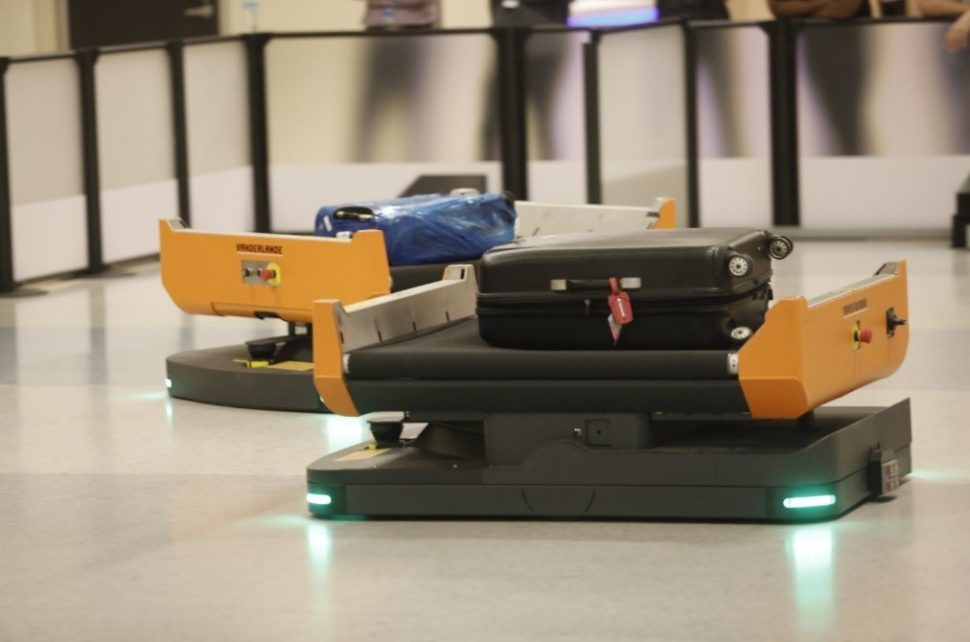The first-of-its kind robotic system can handle almost 450 bags an hour is being tested with transfer passengers who arrive from international flights and connect through DFW.

[Illustration: A-R-T-U-R via iStock]
by Lance Murray • Jun 24, 2019
When you take a flight at any airport, one of the most important parts of the traveling experience is the rapid, seamless handling of luggage. Dallas Fort Worth International Airport recently announced that it is testing innovative robotic technology to help its customers get their bags with as little hassle as possible.
DFW Airport said it will use the Netherlands-based Vanderlande’s autonomous vehicle solution, FLEET, in the recheck area in Terminal D. It’s a first-of-its kind robotic system that can handle almost 450 bags an hour, and it’s being tested with transfer passengers who arrive from international flights and connect through DFW.
READ NEXT: Project Runway: New Innovation Officer Tackles Travel Roadblocks at Dallas Fort Worth Airport
“DFW is testing the process to see how we might provide our customers with a more seamless journey using the award-winning technology within our current baggage infrastructure, and integrating automation for efficiency,” Khaled Naja, DFW’s executive vice president of Infrastructure and Development, said in a statement. “As we go through the pilot program, DFW will evaluate this new technology and assess potential applications of robots and autonomous vehicles at different points within the Airport.”
The airport said customers participating in the pilot program will use one of four self-bag drop units and identify the airline for their connecting flight using the touch screen. During the transfer, each FLEET vehicle will transport one piece of luggage, transferring the passenger’s bag to the appropriate baggage belt.

DFW Airport and Vanderlande are piloting a robotic luggage transfer system at the airport. [Photo: Courtesy Dallas Fort Worth International Airport]
Dallas Fort Worth Airport grows with new technologies
“This particular application is both exciting and challenging for us, because FLEET will be working in a passenger area,” Andrew Manship, Vanderlande’s executive vice president of airports, said in a statement. “Vanderlande believes FLEET aligns with the airport’s vision, because they have a strong commitment to improving the passenger experience, as well as showcasing the latest innovations.”
As one of the world’s busiest airports, efficient transfer of luggage at DFW is critical–more than 69 million customers go through its gates every year. The airport handles flights from 182 domestic and 62 international nonstop destinations worldwide every day.
Vanderlande, acquired in 2017 by Toyota Industries Corp., is a global leader for value-added logistic process automation at airports, as well as the parcel market.
The robot baggage transfer system is the most recent innovative venture for the nearly 50-year-old airport, which announced earlier this year that it plans to construct a sixth terminal (Terminal F) and undertake a $3-$3.5 billion renovation of Terminal C by 2025.
DFW Airport’s new chief innovation officer, Paul Puopolo, is propelling its future by welcoming new strategies to make the airport better.
“The technology that can be applied to the city can be applied at the airport,” because for Puopolo, innovation is “not just about coming up with some cool things. It has to be things that solve a problem and have a business model around them.”
Technologies such as VR, AR, and biometric scanning are just the tip of the iceberg for tackling the airport’s pressing issues, he said.
“There’s a lot of things I think DFW [Airport] represents, much like a city… We had the same challenges, the same issues, the same thing as we’re trying to solve,” Puopolo told Dallas Innovates.
CEO says that evolution is critical for the airport’s future
The airport already has deployed such technologies as dynamic glass windows, which use IoT tech to control room temperature and brightness, display messages, and monitor for break-ins.
Evolution of the airport is important and will pay dividends, CEO Sean Donohue said in May.
“A couple of early innovative projects are paying dividends for our customers,” Donohue said. “We have installed dynamic glass in Terminal A. This technology automatically tints windows, reducing heating, saving air conditioning loads, and creating more comfortable gate rooms for our passengers.”
Vanderlande’s baggage handling systems move 4.2 billion pieces of luggage per year worldwide—that’s 11.5 million bags per day.
Its systems are active in 600 airports including 14 of the world’s top 20.

